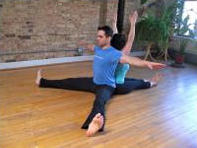Partner Pilates: 3 Fun Moves

In much the same way that Pilates equipment provides assistance and resistance, Partner Pilates helps participants find the proper muscles to execute an exercise effectively. Thanks to the resistance provided by another person, participants are forced to engage muscles and avoid relying on momentum.
Practicing Partner Pilates helps develop that balance of give and take. Within each exercise, both partners act as agonist and antagonist, constantly reiterating the theme: give control, take control.
Structure and Feedback
In a Partner Pilates practice, structural and movement imbalances become just as apparent as communication imbalances. Pilates equipment enhances exercises by providing structure, limits and feedback. Partner Pilates also provides feedback, but in this case, the apparatus is the human body and the feedback is verbal.
The moves can only be accomplished when both partners are tuned in and communicating. The exercises provide strengthening and stretching benefits to both partners at the same time and range from soothing and centering to acrobatic and demanding. They also usually include a healthy amount of laughter and fun.
Ready to give partner Pilates a try? Before you begin, here are some safety tips:
- Partners should be careful not to attempt exercises that are beyond their individual strength or balance capacity.
- As with any exercises, it is important to save enough energy to get out of positions safely and with proper form. If you wait until your last drop of energy to let your partner know you’re losing balance or strength, it’s probably too late.
- Supporting the weight of someone much larger than yourself is not recommended. Otherwise, Partner Pilates is accessible to any healthy body.
Connecting the Spines
We begin every partner Pilates session by simply tuning in. This provides an opportunity to get a feel for the other person and break the ice.
Position. Back-to-back.
Instructions. Partners sit with eyes closed, feeling their own spine against their partner’s. Adopting a common breathing pattern that is comfortable for both, they spend several minutes in this exercise. This primary connection will carry them through the other exercises.
Partners who are enjoying this can start playing with “mirror movement”: moving spines as though they were glued together; side-bending or rolling forward and backward; adding arms. Partners take turns leading and make sure movement stays in sync.
Saw/Twist-Back
Position. Back-to-back.
Instructions. Partner A opens legs and reaches arms out to sides, preparing for saw. Partner A keeps legs straight and together.
Action
- Partner A rotates to right, reaching left hand toward outside of right foot. Back arm reaches around partner, and palm presses up toward ceiling.
- Partner B extends arms toward ceiling, continuing into spinal rotation and extending along curve of partner A’s body.
Imagery. Spines spiral together like double helix or spiral staircase.
Benefits. Partner A is being coaxed further into stretch while having to use additional abdominal strength to support partner B’s weight. Partner B is able to explore challenging extension/rotation action in more passive way.
Double Leg Stretch
Position. Supine, connecting at soles of feet. For proper spacing, each person should be able to bend knees in toward own body without lifting bottom off floor.
Instructions. Warm-Up: Partners practice bending and extending legs, while keeping head down (as in footwork on reformer). Movement is smooth, gliding and symmetrical. Feet travel in direct line, parallel to floor.
Action
- Both partners flex torsos.
- Partner A begins with legs in toward chest and hands on shins (exhale).
- Partner B begins with legs extended and arms overhead (inhale).
- Partners continue on, breathing and alternating roles.
Imagery. When legs are in toward chest, air is literally being “pushed” out by the action. When legs are extended, it helps to imagine they are being pulled long by other partner, in same kind of way that lungs are “pulled” down by diaphragm.
Tip: Keep abdominals “hollowed out,” and find the agonist-antagonist balance of power with partner.
For instructions on a fourth exercise, “Elephant/Handstand,” please see “Partner Pilates” in the online IDEA Library or in the June 2011 issue of IDEA Pilates Today.
Jennifer Golden Zumann
Jennifer Golden Zumann and Matthew Zumann have been inviting people to ÔÇ£fall in love with their spinesÔÇØ for over a decade. They launched the Pilates Chicago Instructor Training Program in 2002, in response to students wishing to train in their unique, mindful-classical approach. When they are not at their studio, Pilates Chicago, you can find Matt and Jen eating, drinking and serving communities during one of their Pilates retreats.




